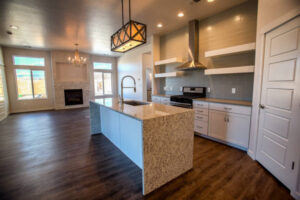The Art and Science of Kitchen Design: Creating Your Culinary Haven
The kitchen is often referred to as the heart of the home. It’s where delicious meals are prepared, memories are made, and the family gathers to share stories and experiences. Given its central role, it’s no surprise that kitchen design plays a crucial part in both the aesthetics and functionality of a home. In this blog post, we’ll explore the art and science of kitchen design, offering insights and tips to help you create your culinary haven.
Form Follows Function
 The first principle of kitchen design is that form should always follow function. Your kitchen’s layout should prioritize practicality and efficiency above all else. This means that the placement of appliances, workstations, and storage should be intuitive and tailored to your specific needs. The classic “kitchen work triangle” concept, which places the stove, refrigerator, and sink in a triangular configuration, remains a valuable guideline for optimal functionality.
The first principle of kitchen design is that form should always follow function. Your kitchen’s layout should prioritize practicality and efficiency above all else. This means that the placement of appliances, workstations, and storage should be intuitive and tailored to your specific needs. The classic “kitchen work triangle” concept, which places the stove, refrigerator, and sink in a triangular configuration, remains a valuable guideline for optimal functionality.
Utilize Space Wisely
Efficient use of space is crucial in any kitchen. Whether you have a small galley kitchen or a spacious open-concept design, make the most of every square inch. Consider adding pull-out pantry shelves, deep drawers, and smart storage solutions to keep your kitchen organized and clutter-free.
Lighting Matters
 Proper lighting can transform the ambiance of your kitchen. A well-lit workspace is essential for safety and functionality. Incorporate a combination of task lighting (under-cabinet lights, pendant lights above the island), ambient lighting (chandeliers or recessed lighting), and accent lighting to create a warm and inviting atmosphere.
Proper lighting can transform the ambiance of your kitchen. A well-lit workspace is essential for safety and functionality. Incorporate a combination of task lighting (under-cabinet lights, pendant lights above the island), ambient lighting (chandeliers or recessed lighting), and accent lighting to create a warm and inviting atmosphere.
Material Selection
The choice of materials plays a significant role in both the aesthetics and durability of your kitchen. Cabinets, countertops, and flooring should be selected with care. While natural stone countertops like granite and quartz offer timeless elegance, consider more budget-friendly alternatives like laminate or solid surface for a modern look. Likewise, hardwood or tile flooring can add warmth and durability to your kitchen.
Color and Style
The color scheme and style you choose will set the tone for your kitchen. Bright, light colors can make a space appear more open and airy, while dark colors can create a cozy and intimate atmosphere. Consider your personal style when selecting cabinet finishes, paint colors, and accessories. Modern, transitional, and traditional are some common kitchen design styles to explore.
Appliances
Modern kitchen design often includes cutting-edge appliances that make cooking and meal preparation a breeze. Stainless steel appliances are a popular choice for their sleek and timeless appearance. When selecting appliances, consider factors like energy efficiency, smart technology, and your cooking needs.
Personalization
A kitchen is a reflection of your personality and lifestyle, so don’t hesitate to add personal touches. Display your favorite dishes, artwork, or even a small indoor herb garden. These touches can make your kitchen feel more inviting and uniquely yours.
 Sustainability
Sustainability
Incorporating sustainable design elements is not only good for the environment but can also save you money in the long run. Choose energy-efficient appliances, eco-friendly materials, and consider recycling and composting in your kitchen design plan.
Kitchen design is a blend of aesthetics and functionality. Your kitchen should not only look beautiful but also support the daily tasks and activities that take place within it. As you embark on your kitchen design journey, remember that it’s a space where you can express your personal style and create a hub for culinary creativity. By carefully considering the principles mentioned in this blog post, you can transform your kitchen into a true culinary haven.